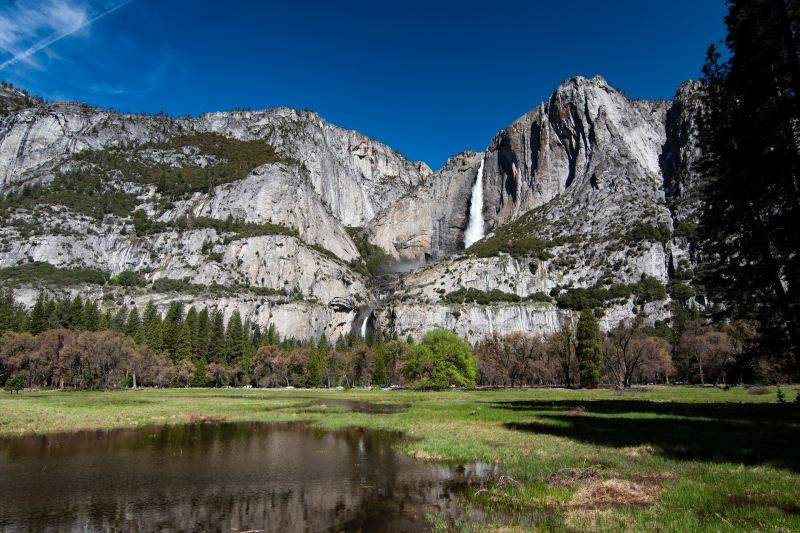Yosemite National Park is a bucket list adventure for many nature lovers, and it’s no surprise why. Year-round, Yosemite offers thrilling experiences, from daring hikes to stunning views. If you’re thinking about planning a trip to Yosemite in the coming year, it can be a challenge to figure out what time you should go. Fortunately, we’ve compiled some of Yosemite’s most thrilling experiences year-round, so you can make an informed decision.
No matter the year, there are a few things you should know. First, Yosemite National Park has an entry fee of $35 per vehicle, but it’s valid for seven days. An annual pass is available for $70, but if you’re looking to go national park hopping, consider purchasing the “America the Beautiful Parks Pass” for $80. Unlike many national parks, Yosemite is open for 24 hours a day, 365 days per year. Some activities may be closed during certain times of the year, but you can still enjoy exhibits, maps, and access to the wisdom of the National Park Service rangers at visitor’s centers around the park.
Yosemite in the fall

Fall is one of the best times to visit Yosemite. You’ll see mild days from around the 60s to 70s Fahrenheit and cool nights that can easily drop to freezing in October. Be prepared for varying weather patterns, including rain or early snowfall at higher elevations. Because of the drop in temperature and the gloomier weather, you might also see reduced crowds after Labor Day. This means that you’ll experience less traffic on your favorite trails and scenic drives, and there will be more availability for your bucket list activities that require a reservation.
Some favorite fall activities at Yosemite include viewing the fall foliage,
Mono Meadow Trail
- Trail length: 3 miles roundtrip
- Difficulty level: Moderate
The golden grasses and colorful foliage around Mono Meadow Trail make it one of the best places around Yosemite to see the fall colors.
Sentinel Dome and Taft Point Loop
- Trail length: 4.9 miles
- Difficulty level: Moderate
This trail offers a panoramic view of the surrounding area from Sentinel Dome. Along the way, you’ll wind through forests full of autumn hues.
Yosemite in the winter

If you’re all about winter activities, Yosemite National Park in the winter is the best time to visit. As the season permits, you’ll find opportunities for skiing, snowshoeing, and ice skating, especially in areas like Badger Pass. Winter is one of the least-visited times of year for Yosemite, so you can enjoy the winter wonderland practically all by yourself.
However, due to snow, you might find limited access to certain roads or trails. Tioga Road and Glacier Point Road are often closed this time of year, but there are still plenty of things to do. Here are a few trails that we recommend.
Lower Yosemite Fall Trail
- Trail length: 1 mile roundtrip
- Difficulty level: Easy
- Surface: Fully paved and relatively flat
The Lower Yosemite Fall Trail is spectacular any time of year, but it’s special to view it in the winter. While the flow is lighter than in the spring, these falls continue to run, which creates some stunning ice formations. Ice cones can form at the base of the falls, and snow will cover the surrounding areas. There may be some ice along the trail, so be careful along the way.
Yosemite in the spring

If you’re looking for the waterfalls at their peak, definitely visit Yosemite in the springtime. The snowmelt drastically increases the amount of water flowing over Yosemite Falls, Bridalveil Falls, Vernal Fall, and Nevada Fall. This is also the time of year when the wildflowers start to bloom in the Yosemite Valley and the Wawona Meadow. Keep an eye out for black bears, deer, foxes, and bird species as they wake up from winter.
Yosemite in the spring has a lot to offer, including fewer visitors. Here are our favorite walks.
Mirror Lake Trail
- Trail length: 2 miles roundtrip
- Difficulty level: Easy
- Surface: Paved road that transitions to a maintained dirt trail
- Accessibility: Wheelchair accessible. Bicycles are allowed up to the lake.
This hike leads to Mirror Lake, which offers beautiful reflections of Half Dome and Mount Watkins. Suitable for families and casual walkers, this is a great option for everyone. The lake is more prominent in the spring and early summer, so by fall it may be a meadow.
Cook’s Meadow Trail
- Trail length: 1 mile roundtrip
- Difficulty level: Easy
- Surface: Mostly flat boardwalks and paved paths
- Accessibility: Suitable for all ages. This path is wheelchair accessible with assistance.
Cook’s Meadow offers stunning views of Yosemite Falls, Half Dome, and Sentinel Rock. It’s an excellent place for wildlife photography, and there are many interpretive signs along the way for more information about the meadow’s ecosystem.
Yosemite in the summer

Summer offers the fullest Yosemite experience, so if you’re looking to do it all, this is the time to come. By summer, the park’s high country is suitable for all of your favorite summer activities, including hiking, camping, clamping, and rock climbing.
Summer is considered the “dry” season, but thunderstorms can occur in July or August. Unfortunately, this also means it’s the time of year with the most visitors. To help with the congestion, Yosemite has recently implemented a reservation system to help mitigate the crowds. Popular areas such as Yosemite Valley and Glacier Point will be crowded, especially around midday and on weekends. You will probably experience traffic and parking delays, so do your research. You may need to consider using a shuttle service to get to where you want to go.
Here are our favorite hikes for summer.
Cathedral Lakes Trail
- Trail length: 7 miles roundtrip
- Difficulty level: Moderate
On this hike, you’ll be able to explore the Lower and Upper Cathedral Lakes in the Tuolumne Meadows area, which has alpine meadows, plenty of wildflowers, and pond reflections of Cathedral Peak. Just make sure that you bring bug spray, because the mosquitoes will eat you alive.
Clouds Rest Trail
- Trail length: 14.5 miles roundtrip
- Difficulty level: Strenuous
A round trip from the Sunrise Lakes Trailhead, Clouds Rest Trail is an incredibly difficult hike, but it’s worth it if you make it to the end. When you summit Clouds Rest, you’re rewarded with sweeping views, including a unique perspective of Half Dome that you won’t get anywhere else. That said, it’s not for the faint of heart. The final stretch includes crossing a narrow bridge, so skip this one if you hate heights.
No matter what time of year you choose to visit, Yosemite National Park has an unforgettable adventure in store for you. Whether it’s snowshoeing or catching the fall colors, choose the experience that most resonates with you.




